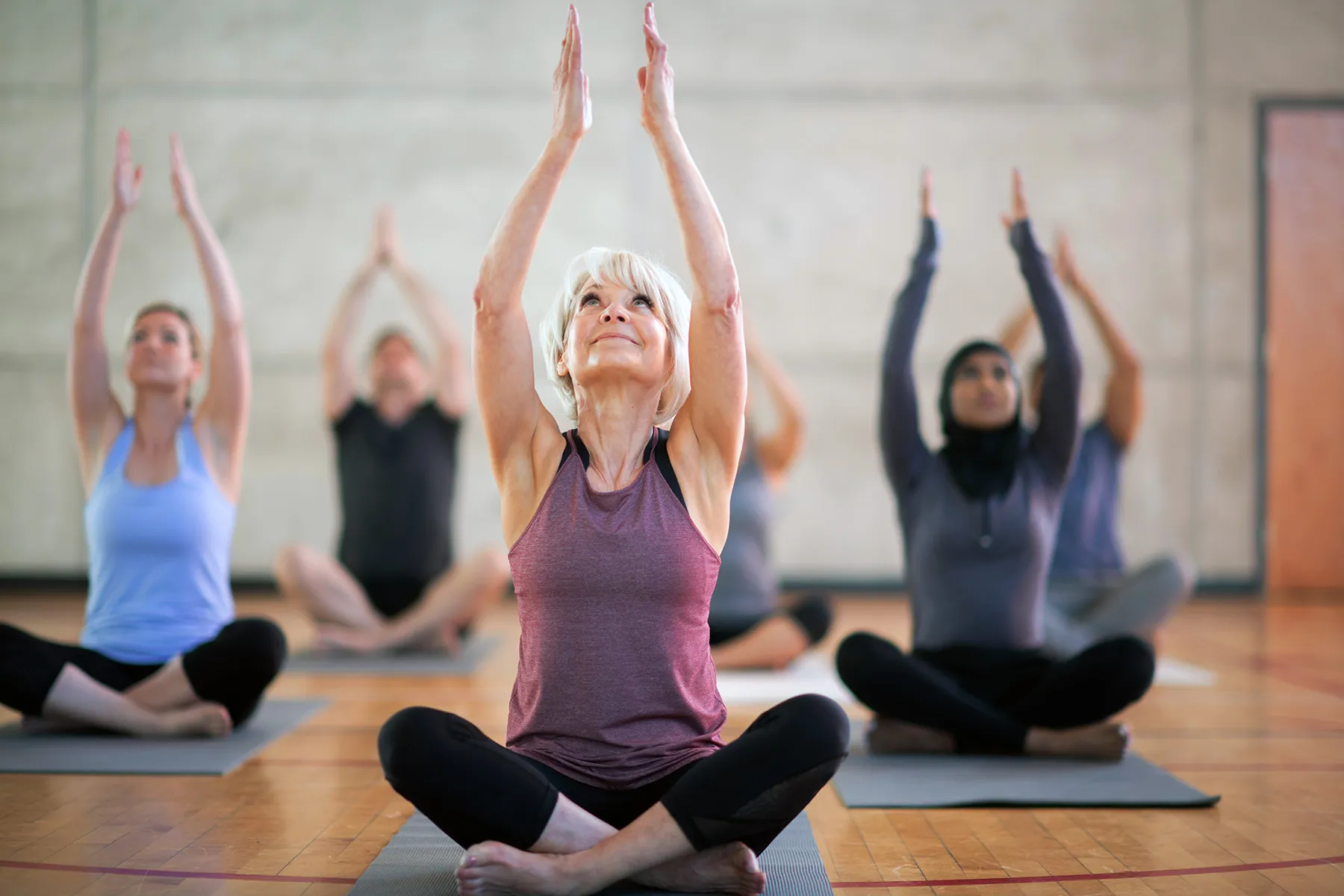Somewhere along the line you may have decided you are simply not the yoga type. Sure, you’ve heard the raves about yoga for stress management, but you can barely touch your toes. So there’s no way you’re going to stand on your head or twist your foot behind your neck like a human pretzel. And meditate? Last time you tried to lie still for three minutes you ended up obsessing about the stack of bills on your desk and what to have for dinner. Not exactly Zen material.
But now that everyone in America seems to be acquainted with the physical and psychological benefits of yoga for stress management and more, you may be feeling a little left out. And so you should.
“The benefits of yoga include decreased stress and tension, increased strength and balance, increased flexibility, lowered blood pressure and reduced cortisol levels,” says Beth Shaw, Founder/President of Yogafit Training Systems, Worldwide, Inc., in Torrance, Calif.
Never Too Late to Begin Yoga for Stress Management
Need more convincing? The American Council on Exercise (ACE) recently studied the physical benefits of yoga and found that “the regular practice of Hatha yoga significantly improved the subjects’ flexibility, muscular strength and endurance, and balance. After eight weeks, the average flexibility of the yoga group improved by 13% to 35% … Similarly, the yoga group’s muscular strength and endurance was also boosted by regular Hatha yoga.”
Yoga’s emphasis on breathing and the mind/body/spirit connection also yields strong emotional benefits. People who practice yoga frequently report that they sleep better and feel less stressed. “It helps you learn not to concentrate on things you can’t control, to live in the present,” says Mindy Arbuckle, yoga teacher and owner of Green Mountain Yoga in Arvada, Colo. “It seeps into the rest your life. You’ll notice you’re handling a stressful event more easily, whether it’s family or work.”
So even if your mother already knows more about it than you do, it’s still not too late to catch up. If you’re finally ready to give it a try, here’s how to get started.
- Step One — Move Past the Myths
The first step is to give up all the preconceptions that are holding you back. First big myth: you have to be flexible to do yoga. “People who aren’t flexible will actually see results faster,” says Shaw. “I’ve taught people who are well into their 90s.”
Because yoga is a practice geared to helping you become aware of your own highly individual mind/body connection, it’s perfectly suited to all levels. “Anyone will get the benefits,” insists Shaw.
Look for classes that specify they are for beginners or are “open” classes, which are for all levels. “It’s important to find a responsible teacher that you respond to,” Arbuckle says. “Because there are so many different styles of yoga out there now, you may want to try a few different types of classes until you find what you like best.” Hatha yoga is one of the most flowing and gentle options, making it a good starting point; Vinyasa is more athletic; and Iyengar concentrates on proper alignment. The only type that Arbuckle wouldn’t recommend for beginners is Bikram, or “hot” yoga.
- Don’t Worry About Whether You’re Doing It ‘Right’
Don’t worry that you are coming to yoga late and you’ll be way behind. “It’s not about doing it better or worse than someone else, it’s about how you feel each stretch in your own body,” says Arbuckle. The names of poses — and chants of om — are beside the point. The only test, according to lifelong yoga practitioners, is how relaxed you can allow yourself to feel. Now that wasn’t hard, was it?
Yoga is a deeply personal practice and no two people can or should hold a pose in exactly the same way. It’s important to work at your own level of flexibility, one that makes you feel challenged but not overwhelmed. “If a teacher is telling you to do something that doesn’t feel good for your body, then don’t do it,” Arbuckle says. “Your body will warn you if you are about to get hurt.” The key is to listen to your body, push the limits gently, but don’t let yourself be overcome by ego. “Allow your body to guide you and be your friend.”
- Concentrate on Your Breath
The goal of yoga is to marry the breath to movement. Most teachers will tell you when to inhale and exhale as you work through poses. “Breathe through your nose only,” Shaw advises. “This keeps heat in the body and keeps the mind focused.” Concentrating on your breath is the key to yoga for stress management, as it helps you let go of external thoughts and anxiety. “The easiest way to bring yourself into the present moment is to focus on your breath,” Arbuckle says. “Feel how it goes down your nose and into your body. It helps you let go of the worrying thoughts.”
Every yoga class ends with ‘corpse pose, a pose designed for deep relaxation. Simply lie on your back with your arms at your side and your eyes closed, breathing deeply. See how easy it is — you’ve learned a yoga pose already.
- Let Go of Competitiveness
It can be hard in a class not to look sideways and notice the lithe young thing balancing on one leg while you teeter and flail. But it’s important to remember that yoga truly is about you. “The biggest mistake beginners make is having expectations. Yoga is a process and it can be slow. Let go of competition and judgment,” says Shaw. “Yoga is supposed to bring us into the present moment. You will find joy in not only the physical movement and mental benefits but in spending time in the now,” Shaw says. “Where else can you get that kind of mental vacation?”
And you don’t even have to send postcards home.












![Ep265: [Lean Series] 5 Ways You’re F*cking Up Your Fat Loss Ep265: [Lean Series] 5 Ways You’re F*cking Up Your Fat Loss](https://carrotsncake.com/wp-content/uploads/2025/01/IMG_3025-768x1024-1.jpg)

![Ep264: [Lean Series] What Happens If You Diet Too Soon Ep264: [Lean Series] What Happens If You Diet Too Soon](https://carrotsncake.com/wp-content/uploads/2022/11/What-to-eat-to-balance-your-hormones-768x509.jpg)






Discussion about this post